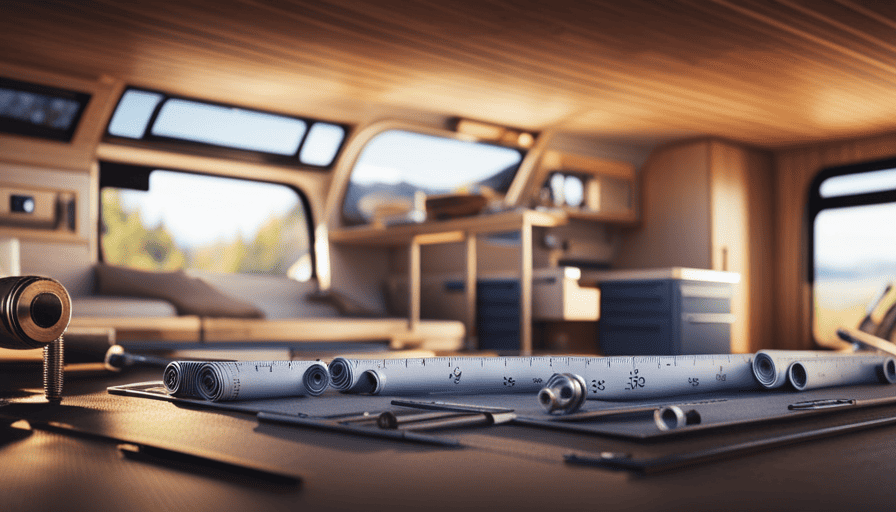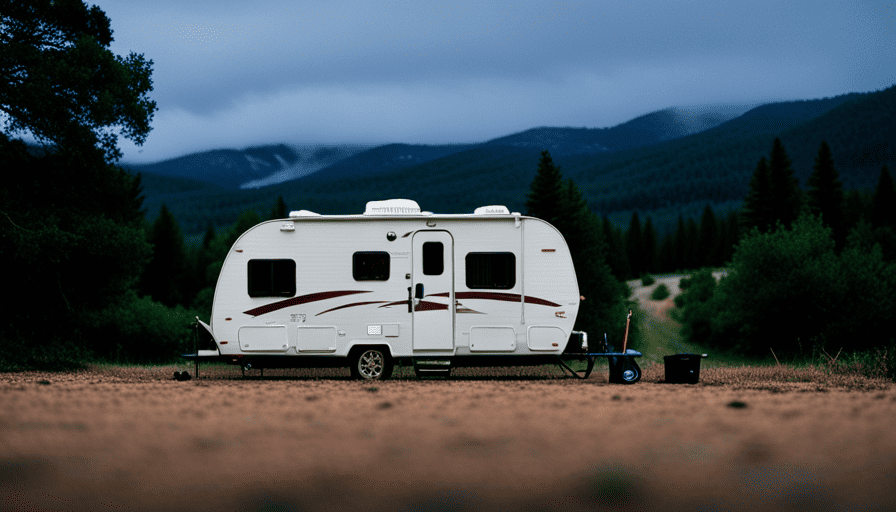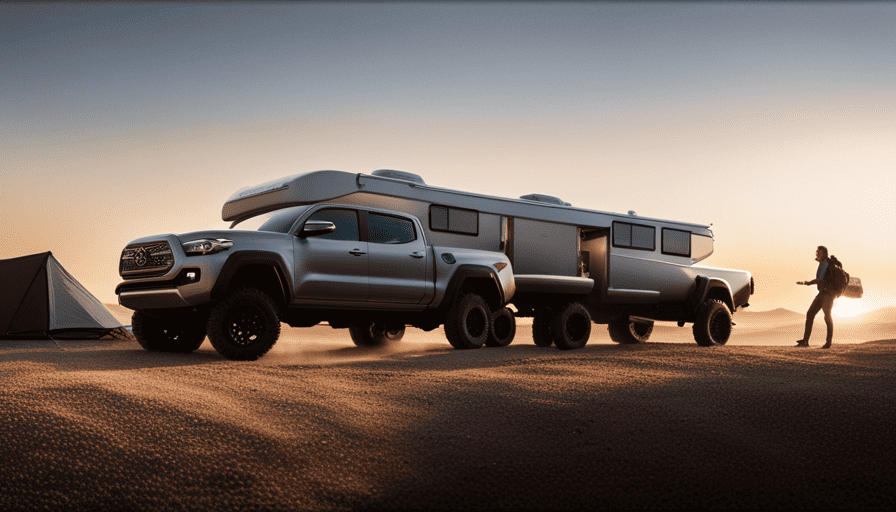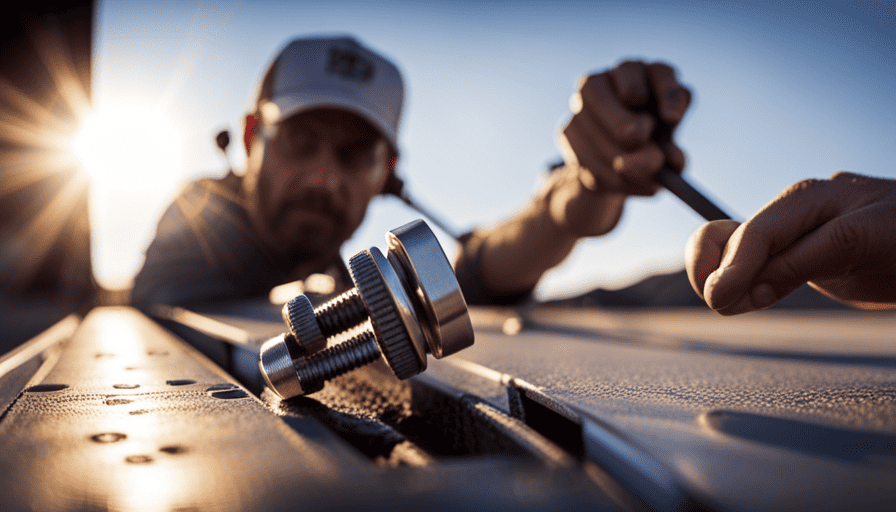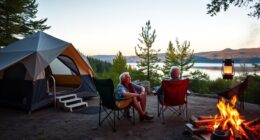Did you know that the cost of a new camper can vary greatly, ranging from $10,000 to $100,000? This is a substantial investment for nature lovers who want to enjoy the outdoors without breaking the bank.
Luckily, building your own camper on a trailer frame is a cost-effective alternative that allows you to customize your living space to fit your exact needs and preferences.
In this article, I will guide you through the step-by-step process of building your own camper on a trailer frame. From choosing the right trailer frame to constructing the camper shell and installing interior features, I will provide you with all the technical details and precise instructions you need to create your own DIY camper.
So, if you’re ready to embark on an exciting and budget-friendly adventure, let’s get started!
Key Takeaways
- Building your own camper on a trailer frame is a cost-effective alternative to purchasing a new camper
- Customizing the living space allows for personalized design and functionality
- Considerations such as budget, design requirements, permits, and insurance should be taken into account
- Steps involved in building a camper on a trailer frame include choosing the right trailer frame, constructing the camper shell, installing insulation, windows, doors, ventilation systems, electrical and plumbing systems, and adding interior features and finishes
Determine Your Budget and Design Requirements
Are you ready to embark on the adventure of building your own camper on a trailer frame, but not sure where to start? Well, the first step is to determine your budget and design requirements. Next, you’ll need to research and source the necessary camper building materials, which can include plywood, insulation, siding, roofing materials, and more. Consider the weight of the materials and how they will affect the towing capacity of the trailer when fully loaded. Once you have a clear vision of your budget and design requirements, as well as a list of necessary materials, you can start planning and sketching out your camper design. Once you have a clear idea of your budget and design requirements, you can start researching and gathering materials. Look for reliable sources of information, such as DIY camper building tips, to help guide you through the process. Additionally, consider reaching out to experienced builders or joining online communities to learn from others who have successfully built their own campers.
When it comes to determining the budget, it’s important to consider all the costs involved in building a camper on a trailer frame. This includes not only the materials and tools needed, but also any additional expenses such as permits, insurance, and inspection fees. By setting a realistic budget, you can ensure that you have enough funds to complete the project without any unexpected financial stress.
Next, you need to consider your design requirements. Are you looking for a compact camper that can accommodate just a few people, or do you need something larger with more amenities? Think about the number of beds, kitchen facilities, storage options, and any other features you want to include. This will help you create a clear vision for your camper and guide your decision-making process.
Now that you have determined your budget and design requirements, it’s time to choose the right trailer frame. By considering the weight capacity, towing capabilities, and overall stability of the trailer frame, you can ensure that it is suitable for your camper build.
With these factors in mind, you can move on to the next stage of your camper building journey.
Choose the Right Trailer Frame
To ensure a successful project, you should carefully consider the weight capacity and dimensions of the chosen trailer before proceeding with your camper conversion.
For example, imagine you have a vintage Airstream trailer that needs a new lease on life as a cozy camper. The trailer frame dimensions play a crucial role in determining the overall size and layout of your camper. Measure the length, width, and height of the trailer frame to ensure it can accommodate your design requirements.
Additionally, consider the weight capacity of the trailer frame to ensure it can safely carry the weight of your camper and all its contents.
When choosing the right trailer frame, it’s important to also consider the materials used in its construction. Common materials include steel, aluminum, and composite. Steel frames are sturdy and durable but may be heavier. Aluminum frames are lightweight and resistant to corrosion, but they can be more expensive. Composite frames offer a balance between strength and weight, making them a popular choice for camper conversions.
To proceed with your camper conversion, gather the necessary materials and tools.
Gather the Necessary Materials and Tools
Get ready to embark on your camper conversion adventure by gathering all the materials and tools you’ll need for the project. Choosing the right tools is crucial to ensure a smooth and efficient build.
Some essential tools you will need include a drill with various drill bits, a jigsaw for cutting materials, a circular saw for precise cuts, a tape measure for accurate measurements, and a level to ensure everything is straight and aligned. Additionally, you will need basic hand tools such as screwdrivers, wrenches, and pliers.
Once you have all the necessary tools, it’s time to set up a workspace. Find a well-ventilated area with enough space to work comfortably. This could be a garage, driveway, or even a designated area in your backyard. Clear the space of any clutter and ensure you have enough room to move around and store materials.
With your tools and workspace ready, you can now begin planning and designing the interior layout of your camper. Consider factors such as functionality, storage space, and comfort. Think about the number of beds, seating areas, kitchen facilities, and bathroom amenities you want to include. This will help you create a detailed plan before you start building.
Start gathering your materials and tools, set up a suitable workspace, and get ready to dive into the exciting phase of planning and designing the interior layout of your camper.
Plan and Design the Interior Layout
Start envisioning your dream living space on wheels and create a personalized interior layout that maximizes functionality and comfort for your camper conversion project. When it comes to interior design in a camper, space utilization is crucial. You want to make the most of the limited space available, while still ensuring that everything you need is easily accessible.
To help you plan and design your interior layout, consider using a 3 column and 5 row table. In the first column, list the main areas or zones you want to include in your camper, such as the kitchen, sleeping area, bathroom, and storage. In the second column, note the specific features or appliances you want to incorporate into each area. And in the third column, jot down any additional considerations or notes for each zone.
By using this table, you can visually organize your ideas and ensure that you have accounted for all the necessary components in your camper’s interior design. Keep in mind factors such as weight distribution, functionality, and ease of use when planning the layout.
Once you have finalized your interior design, you can move on to the next step of constructing the camper shell.
Construct the Camper Shell
To construct the camper shell, I’ll begin by building the frame and walls of the camper. This involves measuring and cutting the necessary pieces of plywood or metal to create a sturdy structure.
Next, I’ll install insulation to ensure temperature control inside the camper. This step is crucial for maintaining a comfortable environment regardless of the weather conditions.
Finally, I’ll add windows, doors, and ventilation systems to allow for natural light, easy access, and proper airflow within the camper. These elements are essential for creating a functional and comfortable living space.
Build the Frame and Walls of the Camper
Constructing the frame and walls of the camper involves carefully measuring and cutting the materials, ensuring proper alignment and stability for a sturdy and well-built structure. To start, I used building techniques such as square cuts and precision measurements to create a solid foundation. The frame was built using treated lumber and reinforced with metal brackets for added strength. For the walls, I used plywood panels and secured them to the frame using screws. To maximize interior storage, I incorporated a 2 column and 4 row table in markdown format to organize and plan the layout efficiently. This allowed me to optimize space for cabinets, closets, and other storage solutions. By incorporating these building techniques and thoughtful design, I was able to create a functional and practical living space. Next, I will discuss how I installed insulation for temperature control.
Install Insulation for Temperature Control
After carefully measuring and cutting the materials, I used treated lumber and metal brackets to reinforce the frame, creating a solid foundation for the camper walls. To ensure optimal temperature control inside the camper, I decided to install insulation.
Soundproofing techniques were also taken into consideration. Before selecting the insulation material, I evaluated various options based on their R-value, which measures thermal resistance. Ultimately, I chose closed-cell spray foam insulation due to its high R-value and ability to provide an airtight seal. This insulation material effectively prevents heat transfer and minimizes noise infiltration from the outside.
I meticulously applied the foam insulation to the interior walls and roof, ensuring complete coverage. With the insulation in place, the camper is now ready for the next step: adding windows, doors, and ventilation systems to create a comfortable and well-ventilated living space.
Add Windows, Doors, and Ventilation Systems
Now that the insulation is in place, it’s time to bring in the natural light, fresh air, and a sense of freedom with the addition of windows, doors, and ventilation systems. Here’s what you need to consider when adding these features to your camper:
-
Window placement: Carefully select the placement of your windows to maximize natural light and provide scenic views. Consider the size and shape of the windows to ensure they fit well with the overall design.
-
Ventilation options: Incorporate various ventilation systems to maintain a comfortable interior temperature. This can include roof vents, windows that open, and exhaust fans. Strategically place these elements to promote airflow and prevent condensation buildup.
-
Weatherproofing: Ensure that all windows and doors are properly sealed to prevent leaks and drafts. Use weatherstripping and silicone sealant to create a tight seal.
-
Security: Install sturdy locks on doors and windows to keep your camper safe and secure.
-
Privacy: Consider adding blinds or curtains to provide privacy when needed.
With the windows, doors, and ventilation systems in place, it’s time to move on to the next step of installing electrical and plumbing systems.
Install Electrical and Plumbing Systems
First things first, let’s dive into the exciting world of installing electrical and plumbing systems in your camper-on-a-trailer, making it a true oasis on wheels.
When it comes to electrical wiring, it’s crucial to plan the layout carefully. Begin by mapping out the locations of outlets, lights, and appliances. This will help determine the placement of electrical panels and the routing of wires. Use appropriate wire gauges and connectors to ensure safety and efficiency. Don’t forget to install a breaker box to protect the system from overloading.
For plumbing installation, start by determining the locations of water tanks, pumps, and fixtures. Use PEX pipes for water supply lines as they’re flexible, durable, and easy to install. Connect the pipes using crimp fittings to prevent leaks. Install a water pump to provide the necessary pressure for water flow. Don’t forget to include a water heater if desired.
Now that the electrical and plumbing systems are in place, it’s time to move on to the next section about installing interior features and finishes. This will transform your camper-on-a-trailer into a comfortable and functional living space on the go.
Install Interior Features and Finishes
To truly transform your mobile oasis, you need to focus on installing the interior features and finishes that’ll make your living space on wheels feel like a cozy home away from home.
One important aspect to consider is furniture arrangement. Since space is limited in a camper, it’s crucial to plan the layout strategically to maximize functionality. Opt for multipurpose furniture, such as a sofa that can convert into a bed or a table with built-in storage compartments. This’ll help optimize the available space and ensure every inch is utilized efficiently.
Another crucial element to consider is interior color schemes. Choose colors that create a welcoming and calming atmosphere. Lighter tones can make the space feel more open and spacious, while darker shades can add a touch of elegance and coziness. Incorporate pops of color through throw pillows, curtains, or accent pieces to add personality to your camper’s interior.
With the interior features and finishes in place, it’s time to move on to the next step of the process – testing and inspecting the camper’s functionality. By ensuring that all electrical and plumbing systems are working efficiently, you can rest easy knowing that your mobile home is ready for any adventure that lies ahead.
Test and Inspect the Camper’s Functionality
Ensure that everything is in proper working order by testing and inspecting the functionality of your mobile oasis, so you can embark on your next adventure with peace of mind.
To ensure the camper’s functionality, it’s essential to conduct thorough test methods and follow necessary safety precautions.
Firstly, start by testing the electrical system. Check if all the lights, including the headlights, taillights, and interior lights, are functioning correctly. Test the power outlets, ensuring they provide a stable supply of electricity. Additionally, verify that the battery is charging efficiently and that the solar panels are generating sufficient power.
Next, inspect the plumbing system to ensure it’s leak-free. Run water through all the faucets, checking for any signs of leakage. Test the water pump to ensure proper water flow and pressure. It’s crucial to examine the waste disposal system, such as the toilet and greywater tank, to ensure they’re functioning correctly.
Furthermore, evaluate the heating and cooling systems. Test the air conditioning unit and the heater to ensure they’re working efficiently. Check for any strange noises or unusual smells that might indicate a problem.
Once the functionality tests are complete, make any necessary adjustments or improvements to ensure optimal performance.
Make Any Necessary Adjustments or Improvements
After completing the functionality tests, it’s time to tweak and enhance your mobile oasis for optimal performance and an unforgettable adventure.
When it comes to maximizing space and storage in a camper, there are a few considerations to keep in mind. Firstly, utilizing vertical space is key. Install overhead cabinets or shelves to store items that aren’t frequently used, such as extra bedding or off-season clothing. Additionally, consider investing in collapsible furniture or storage solutions that can be folded away when not in use. This will allow for more open space during the day.
Ensuring the camper is structurally sound and safe for travel is of utmost importance. Take the time to inspect the frame for any signs of wear or damage. Reinforce weak points and repair any areas that show signs of deterioration. It’s also crucial to check the stability of the camper when it’s attached to the trailer frame. Make sure all connections are secure and that the camper is properly balanced. This’ll help prevent any accidents or damage while on the road.
With these adjustments and improvements made, your DIY camper is now ready for adventure. Hit the open road and enjoy the freedom that comes with having your own mobile getaway.
Transitioning into the subsequent section, let’s explore how to fully enjoy your DIY camper and embark on unforgettable journeys.
Enjoy Your DIY Camper and Hit the Open Road
Now that your DIY camper is complete, it’s time to hit the open road and experience the thrill of embarking on unforgettable journeys in your very own mobile oasis.
After all the hard work and adjustments made to build your camper on a trailer frame, it’s time to enjoy the fruits of your labor.
One of the great benefits of traveling in a camper van is the flexibility and freedom it provides. With your DIY campervan modifications, you can customize your living space to suit your needs and preferences. Whether you prefer a cozy bed, a functional kitchenette, or a spacious seating area, your camper van can be tailored to your liking.
Additionally, traveling in a camper van allows you to explore remote and off-the-beaten-path destinations. You can wake up to breathtaking views, cook meals in nature, and truly immerse yourself in the great outdoors. The convenience of having all your essentials in one place, from a comfortable bed to a functional kitchen, makes traveling in a camper van a convenient and enjoyable experience.
So, pack your bags, fuel up your camper van, and get ready to embark on incredible adventures. The open road awaits, and with your DIY camper, you have the perfect vehicle to create memories that will last a lifetime.
Frequently Asked Questions
What are the legal requirements for towing a camper on a trailer frame?
I investigated the truth of the theory surrounding the legal requirements for towing a camper on a trailer frame.
When it comes to towing a camper, there are strict regulations to ensure safety on the road. Towing laws vary by region, but common requirements include adhering to trailer weight restrictions, following towing safety guidelines, and complying with specific camper towing laws.
It’s crucial to familiarize yourself with these regulations to avoid any legal issues and ensure a safe towing experience.
How do I insulate the camper shell to ensure comfort in different weather conditions?
To ensure comfort in different weather conditions, I recommend using high-quality insulating materials and weatherproofing techniques.
For insulation, consider using materials like rigid foam board or spray foam insulation, which provide excellent thermal resistance.
To weatherproof the camper shell, use weatherstripping on doors and windows, seal any gaps or cracks, and apply a waterproofing membrane on the exterior.
These measures will help maintain a comfortable interior temperature and protect against moisture and drafts.
What type of flooring is best suited for a camper on a trailer frame?
When it comes to choosing flooring for a camper on a trailer frame, it’s crucial to consider both insulation and durability.
Types of insulation, such as foam or fiberglass, can provide added comfort and protection against temperature fluctuations.
As for flooring, opt for materials that are lightweight, waterproof, and easy to clean, like vinyl or laminate.
It’s important to choose flooring that can withstand the rigors of travel and provide a cozy environment for your adventures.
Remember, comfort starts from the ground up.
How can I maximize storage space in the interior layout of the camper?
To maximize storage space and organize the interior layout of a camper, several strategies can be employed.
Utilize vertical space by installing overhead cabinets and shelves.
Opt for multifunctional furniture, such as beds with built-in storage drawers.
Utilize every nook and cranny by adding storage compartments under benches and in unused corners.
Install hooks, racks, and magnetic strips to hang and store smaller items.
Consider collapsible or stackable storage solutions to optimize space efficiency.
Are there any safety considerations or regulations I should be aware of when installing electrical and plumbing systems in the camper?
When it comes to safety regulations for electrical system installation in a camper, there are a few key considerations to keep in mind.
First, ensure that all electrical components meet the necessary safety standards and are installed correctly. This includes using properly rated wiring, circuit breakers, and outlets.
Additionally, it’s important to have a clear understanding of the load capacity and power requirements of your camper to prevent overloading the electrical system.
Finally, make sure to properly ground all electrical components to minimize the risk of electric shock.
Can I Use a Camper Slide Out in My Trailer Frame Build?
Yes, you can use a camper slide out in your trailer frame build. Incorporating a build a camper slide out feature provides additional space and comfort during your travels. This feature allows you to expand the living area while parked, making your trailer feel more spacious and accommodating.
Conclusion
Well, would you look at that! After all the blood, sweat, and tears, my DIY camper’s finally complete. I can proudly say I built this beauty from scratch, right on top of a trailer frame. It wasn’t easy, but with determination and a little bit of insanity, I did it.
Now, I can hit the open road and experience the joys of camping in my very own creation. Who needs fancy RVs when you can have a personalized, one-of-a-kind camper?

